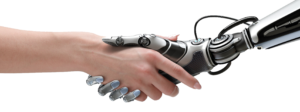The Era of AI 2.0
AI 2.0
Until now we have mostly been collecting data into large datasets, and less than 10% of all datasets created over the last 10 years has never been even analysed. We are in a paradigm shift, going from collecting data, to actually use the datasets to make behaviour predictions or outcome of the future. However, the real value proposition is when we finally are able to use the data to make prescriptions not by just predicting what customers are doing, but also why they are doing to gain insights of the future [1].
The emerge of artificial intelligence and cognitive computing is disrupting how we can process new data and generate predictions by powerful machine learning algorithms .
In the late 1990s, as great advancements in computing power (Moore´s law) accelerated the rise of machine learning and training computers to analyse high volumes of complex datasets to derive underlying patters and yield high-accuracy predictions and insights that humans would not be able to determine due to the volume of complexity datasets [2].
As more dataset is analysed, the more it learns and it evolves over time, however most of the data gathered is unstructured data, which is typically data and text-heavy documents that is not organised or have a pre-defined data model. Today about 80% of all data gathered is unstructured, and is growing at 15 times of structured data.
Machine learning & Cognitive Computing
Machine Learning techniques are built on classical statistics to make statistical modelling to gather insights and learn from data, create and test algorithms run on powerful computers and neural networks to create accurate predictive models. However, an important aspect is to identify the gaps in incomplete data, clean and remove noise from messy datasets, before we can make it into reliable quality data of high value.
We can categorize machine learning mainly into two categories; Supervised learning and Unsupervised learning; Supervised learning is using training data to create a program that can make estimates by feeding training data into the machine learning algorithm to estimate parameters. The algorithm would discover underlying patters and figure out the relationship between different parameters, to make prediction of an estimate.As the training data set gets larger, the models train itself to becomes even more accurate. Unsupervised learning is when we know some parameters but we don’t know the correct answer for the output. However, the algorithm would figure out patterns and identify outliers.
Applications of Cognitive Computing
Machine learning can be used in many applications, such an example is the successful company Zillow [3], that uses machine learning to find patterns in existing dataset to generate predictions is the residential real estate market [4]. Zillow was founded in 2006 by former Microsoft executives and founders or Expedia, and its zestimate [5], predicts any value of real estate and current trends in the US residential housing market by complex valuation models on data from multiple sources [6].

“The winners will be neither machines alone, nor humans alone, but the two working together effectively”
The optimal combination of a man-machine collaboration is when machines can identify underlying patterns, and translate them data into something human can interpret and outlay a recommended course of action for better decisions and emerging business models [9] For now, we cannot compare cognitive computing to human cognitive, their responses are mostly pre-programmed. However, it is emerging and a time will come that we will work as a human brain, and we will get sophisticated responses from a computer.
References
[1] http://www.mckinsey.com/industries/high-tech/our-insights/an-executives-guide-to-machine-learning
[2] https://www.forbes.com/sites/bernardmarr/2016/03/23/what-everyone-should-know-about-cognitive-computing/#432592755088
[3] http://www.informationweek.com/big-data/zillow-uses-analytics-machine-learning-to-disrupt-with-data/d/d-id/1327175
[4] www.zillow.com/
[5] https://www.zillow.com/zestimate
[6] https://www.zillow.com/research/data.
[7] http://vr-zone.com/articles/ai-writes-code-stealing-others/122629.html
[8] http://www.mckinsey.com/industries/high-tech/our-insights/an-executives-guide-to-machine-learning
[9] http://www.informationweek.com/big-data/big-data-analytics/what-ebays-machine-learning-advances-can-teach-it-professionals/d/d-id/1326750?itc=edit_in_body_cross.

